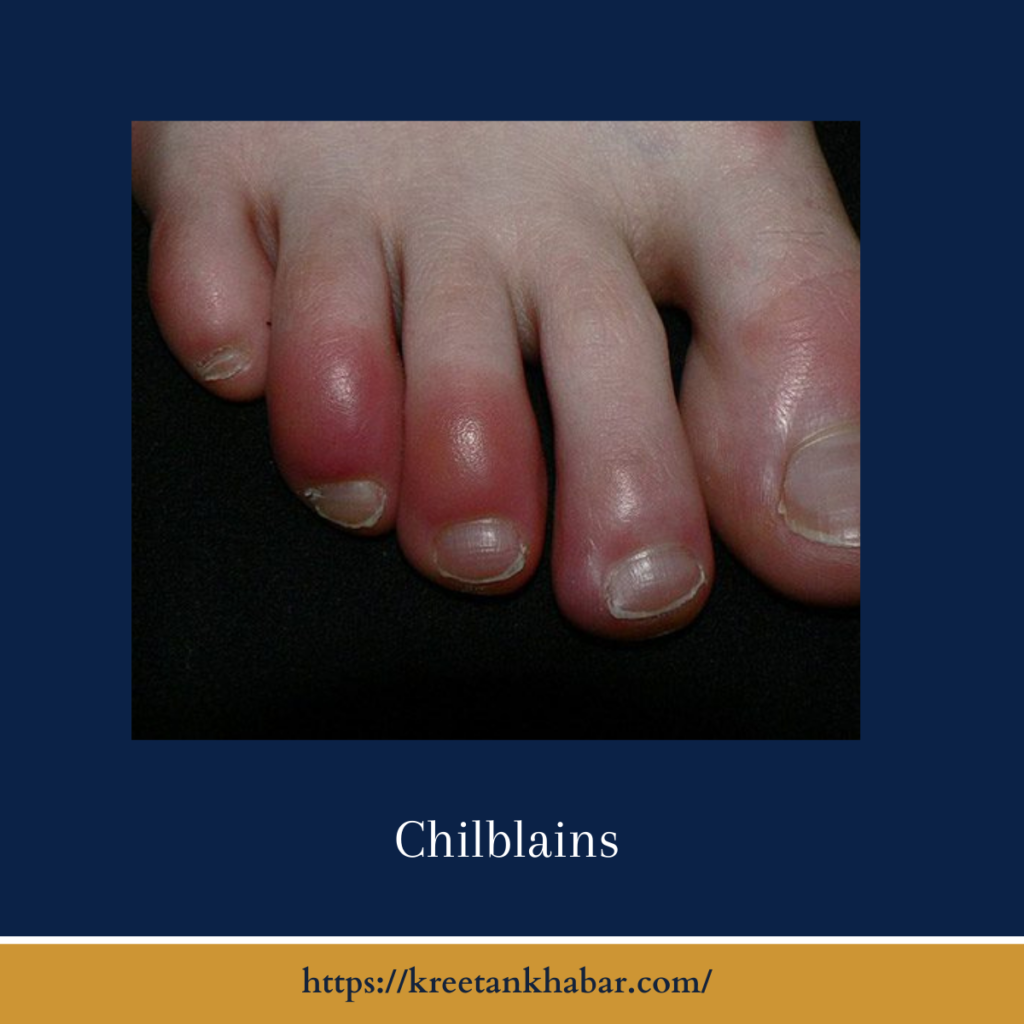Chilblains: Understanding, Preventing, and Treating the Winter’s Nuisance
Introduction
As the winter chill sets in, many of us find ourselves facing not only frosty temperatures but also an uncomfortable and often painful condition known as chilblains. Chilblains, also called perniosis, are a common cold-related skin problem that can affect both adults and children. In this article, we will explore what chilblains are, their causes, symptoms, prevention strategies, and treatment options to help you stay comfortable during the colder months.

Understanding Chilblains
Chilblains are localized areas of inflammation and redness on the skin, typically affecting the fingers, toes, ears, and sometimes the nose. They occur when small blood vessels beneath the skin constrict in response to cold temperatures. When rewarming occurs too quickly, these blood vessels can become damaged, leading to the development of perniosis.
Causes of Chilblains
The primary cause of chilblains is exposure to cold and damp conditions, but several factors can contribute to their development:
- Cold Temperatures: Prolonged exposure to cold weather, especially without adequate protection, increases the risk of perniosis.
- Humidity: High humidity combined with cold temperatures is more likely to trigger perniosis.
- Poor Circulation: Individuals with poor circulation are at a higher risk because their blood vessels may struggle to constrict and dilate appropriately.
- Tight Clothing: Wearing tight-fitting shoes or gloves that restrict blood flow can contribute to perniosis.
Symptoms of Chilblains
Chilblains can cause a range of symptoms, including:
- Reddish or Purplish Skin: Affected areas of the skin may appear red, purple, or even dark blue.
- Itching and Burning: perniosis often cause itching and a burning sensation.
- Swelling: Swelling of the affected skin is common.
- Blisters: In severe cases, perniosis can lead to blistering, which can be painful.
- Skin Discoloration: As perniosis heal, they can leave behind skin discoloration or pigmentation changes.
Preventing Chilblains
Preventing chilblains is largely a matter of staying warm and dry in cold weather:
- Dress Appropriately: Wear warm, loose-fitting clothing, and layer to trap heat effectively.
- Protect Extremities: Keep fingers, toes, ears, and nose well-covered with gloves, socks, earmuffs, and scarves.
- Stay Dry: Moisture exacerbates perniosis, so keep your skin dry. Change wet clothing promptly.
- Avoid Direct Heat: Do not use direct heat sources like hot water bottles or heaters to rapidly warm cold skin, as this can worsen perniosis.
- Maintain Good Circulation: Exercise regularly and avoid sitting or standing in one position for extended periods.
Treating Chilblains
If chilblains do develop, here are some steps to alleviate discomfort and promote healing:
- Warm-Up Gradually: If you’ve been out in the cold, gradually warm the affected areas by placing them in lukewarm water. Avoid hot water.
- Keep the Skin Dry: Pat the skin gently and keep it dry to prevent further irritation.
- Topical Creams: Over-the-counter creams containing corticosteroids or anti-itch ingredients can provide relief from itching and inflammation.
- Avoid Scratching: Resist the urge to scratch, as it can worsen perniosis and lead to infection.
- Medical Consultation: If chilblains are severe or become infected, consult a healthcare professional for appropriate treatment.
here are key points regarding the treatment of perniosis:
Treating Chilblains:
- Gradual Warming: If you suspect or have perniosis, it’s crucial to warm the affected areas slowly. Avoid using direct heat sources like hot water bottles or radiators, as this can worsen the condition. Instead, immerse the affected areas in lukewarm (not hot) water to gradually raise their temperature.
- Gentle Drying: After warming the skin, pat it gently to dry, using a soft towel. Avoid vigorous rubbing, as chilblain-afflicted skin can be delicate and prone to damage.
- Moisturize: Apply a soothing, fragrance-free moisturizer to the affected areas to keep the skin hydrated and prevent further dryness or cracking.
- Topical Creams: Over-the-counter creams containing corticosteroids or anti-itch ingredients can help alleviate itching and reduce inflammation. Follow the product instructions and consult a healthcare professional if needed.
- Pain Relief: Over-the-counter pain relievers like ibuprofen or acetaminophen may help alleviate pain and discomfort associated with perniosis. Follow the recommended dosages and guidelines.
- Avoid Scratching: Itchy chilblains can tempt you to scratch, but it’s essential to resist this urge. Scratching can damage the skin, increase the risk of infection, and slow down the healing process.
- Loose Clothing: Wear loose-fitting clothing to prevent additional irritation and friction on perniosis.
- Elevate Affected Areas: Elevating the affected areas, especially if they are swollen, can help reduce swelling and promote blood circulation.
- Protective Measures: To prevent further chilblains, continue to protect yourself from cold and damp conditions. Dress warmly, keep extremities covered, and stay dry.
- Medical Consultation: If chilblains are severe, painful, or become infected, it is advisable to seek medical attention. A healthcare professional can provide appropriate treatment and address any complications.
- Prevent Recurrence: Take preventive measures to avoid future occurrences of perniosis by staying warm, dry, and well-insulated in cold weather.
Remember that while the above steps can help manage the symptoms of perniosis and promote healing, prevention is key. Taking precautions to protect yourself from cold and damp conditions can significantly reduce the risk of developing chilblains in the first place.
Conclusion
Chilblains may be an unpleasant surprise during the winter months, but with proper prevention and care, you can minimize their impact on your comfort and well-being. By staying warm, dry, and attentive to your skin, you can brave the cold weather with confidence and keep perniosis at bay.
Read also : Exploring the Delightful Boost of the Green Tea Shot 2023